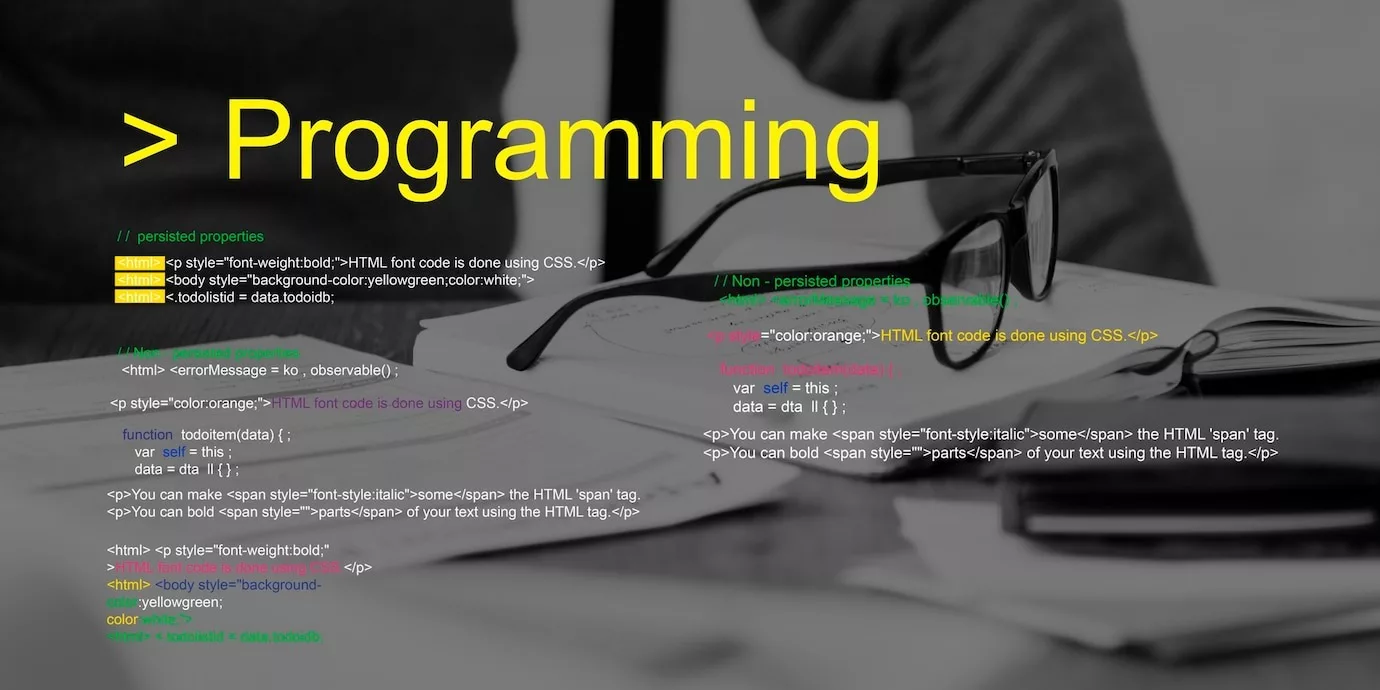JavaScript holds a commanding position in the tech industry. It has an astonishing 78% usage rate among developers. This statistic reaffirms JavaScript’s dominance and underscores its undeniable importance in shaping the modern digital landscape.
Gone are the days of static HTML websites. Instead, we opt for web applications that are dynamic, interactive, and responsive to the user’s every move. In this dynamic environment, exploring advanced JavaScript techniques has become a necessity to excel in modern front-end development.
In this guide, we will dive deep into the intricacies of JavaScript, from its fundamental concepts to its cutting-edge techniques. Today, we’ll equip you with the knowledge and skills to thrive in front-end development to keep you ahead of the curve.
The Fundamentals of JavaScript

To truly understand advanced JavaScript techniques and their role in modern front-end development, it’s essential to grasp the foundational concepts of JavaScript. JavaScript is a versatile and powerful programming language, often abbreviated as JS. It adds interactivity and dynamism to web pages.
Variables and Data Types
JavaScript is all about managing data. To do this effectively, front end developers use variables. Variables are like containers that hold different types of data, such as numbers, strings (text), booleans (true/false), and more. Understanding data types and how to work with variables is fundamental to writing JavaScript code.
Functions
Functions are blocks of code that are called and executed. They encapsulate a set of operations that take inputs (arguments) and return results. Functions are vital for organizing and reusing code.
Control Structures
JavaScript includes control structures like if statements and loops (e.g., for and while loops) that allow you to make decisions and repeat actions based on conditions.
Objects and Arrays
Objects and arrays are essential data structures in JavaScript. Objects allow you to store and manipulate data in key-value pairs, while arrays are used to store collections of data.
Scope and Context
JavaScript has function-level scope, which means variables declared inside a function are not accessible outside of it. Understanding scope is crucial for avoiding bugs and writing maintainable code.
Advanced JavaScript Concepts

As a versatile and dynamic programming language, JavaScript offers a wide range of advanced concepts and techniques. Mastering these concepts greatly enhances your ability to create robust and interactive web applications. Let’s explore some of the advanced JavaScript concepts that are essential for modern front-end development.
Closures
Closures are a powerful and sometimes misunderstood feature of JavaScript. A closure is a function that “closes over” its surrounding lexical scope, retaining access to its parent function’s variables even after that parent function has completed execution. This enables you to create private variables and maintain a state in your code.
Promises
Promises are a solution to the problem of callback hell (also known as the “Pyramid of Doom”). They allow you to work with asynchronous code in a more readable and manageable manner. Promises represent a value that may not be available yet but will be resolved at some point.
Async/Await
Async/await is a more recent addition to JavaScript that simplifies working with promises. It allows you to write asynchronous code more synchronously, making it easier to read and maintain.
The Event Loop
Understanding the event loop is crucial for managing asynchronous operations in JavaScript. It’s the mechanism that allows JavaScript to handle multiple tasks concurrently, ensuring that your web application remains responsive.
Modules and Module Systems
In modern front-end development, organizing your code into modular pieces is essential for maintainability and scalability. JavaScript supports various module systems, such as CommonJS, ES6 modules, and AMD, which allow you to structure your code into reusable components.
Error Handling
Robust error handling is crucial in production-grade applications. JavaScript provides mechanisms for catching and handling errors gracefully to prevent crashes and improve user experience.
Working with Modern JavaScript Frameworks

Modern JavaScript frameworks have become indispensable tools for building dynamic and interactive web applications. These frameworks provide developers with a structured and efficient way to create user interfaces, manage state, and handle complex interactions.
Why Use JavaScript Frameworks?
- Efficiency: Modern frameworks come with a set of predefined structures and patterns, streamlining your development process. They provide you with clear guidelines for organizing code, making it easier to collaborate on projects.
- Reusability: Frameworks promote the creation of reusable components, reducing redundancy in your codebase. This modular approach improves code maintainability and scalability.
- Performance: Many frameworks optimize rendering and update processes for better application performance. They minimize the need to manipulate the DOM directly, leading to smoother user experiences.
- State Management: Handling application states can be complex. Frameworks often include robust state management solutions, simplifying the process of managing and sharing data between components.
- Community and Ecosystem: Popular frameworks have large and active communities. This means extensive documentation, readily available plugins, and strong support when troubleshooting issues.
Popular JavaScript Frameworks
React
Developed by Facebook, React is a library for building user interfaces. It creates reusable UI components and efficiently updates the DOM. React’s “Virtual DOM” minimizes actual DOM manipulation, improving performance.
Angular
Angular, developed by Google, is a framework that offers a complete web application solution. It provides features like two-way data binding, dependency injection, and a powerful CLI for scaffolding projects.
Vue.js
Vue.js is known for its simplicity and ease of integration into existing projects. It’s a progressive framework, meaning you can use as much or as little of it as needed. Vue’s reactivity system and component-based architecture are key strengths.
Ember.js
Ember.js is a framework that emphasizes convention over configuration. It comes with a set of default conventions and a powerful CLI for generating code and managing project structure.
Svelte
Svelte is a new framework that compiles components into highly optimized vanilla JavaScript at build time. This results in smaller bundle sizes and faster load times. Svelte’s approach simplifies complex applications.
Each of these frameworks has its strengths and is suited to different types of projects and development teams. Choosing the right one depends on factors like your project requirements, your team’s familiarity, and your performance needs.
DOM Manipulation and Event Handling

The Document Object Model (DOM) is the programming interface for HTML and XML documents. It represents the structure of a web page as a tree of objects. Each of its objects is a part of the page, like elements, attributes, and text. DOM manipulation is the process of using JavaScript to interact with and modify this structure dynamically.
Why DOM Manipulation Is Crucial
Dynamic Web Content: DOM manipulation creates dynamic web content. It allows you to update page content, structure, and style based on user interactions or data changes, providing you with a seamless user experience.
User Interaction: To create interactive web applications, you need to respond to user actions like clicks, inputs, and mouse movements. Event handling, a subset of DOM manipulation, is used for this purpose.
Single-Page Applications (SPAs): Modern web applications, such as those built with frameworks like React or Angular, heavily rely on DOM manipulation to update content without reloading the entire page.
How to Manipulate the DOM
JavaScript provides methods and properties to access and manipulate the DOM. Here are some common operations:
Selecting Elements
Use document.querySelector() or document.querySelectorAll() to select HTML elements based on CSS selectors.
Modifying Elements
You can change element properties, attributes, and content using JavaScript.
Creating and Appending Elements
You can create new elements and append them to the DOM.
Event Handling
Event handling allows you to respond to user actions, such as clicks and keyboard input.
Removing Elements
You can remove elements from the DOM using the remove() method.
Traversing the DOM
You can navigate the DOM tree to access parent, child, or sibling elements.
Asynchronous Programming and AJAX

Web applications need to perform tasks that take time to complete. This includes fetching data from a server, handling user input, or running time-consuming operations. Asynchronous programming and AJAX are essential concepts in web development to manage such tasks without blocking the user interface.
Asynchronous Programming
Asynchronous programming is a programming paradigm that allows tasks to run independently of the main program flow. In JavaScript, this is crucial for handling time-consuming operations, like making network requests, reading files, or waiting for user input.
Why Asynchronous Programming Matters
- Responsive User Interface: Long-running tasks would block the user interface without asynchronous programming, making the application unresponsive. Asynchronous operations keep your UI interactive.
- Efficient Resource Usage: Asynchronous code uses system resources better by allowing multiple tasks to run concurrently.
- Fetching Data: Most web applications fetch data from servers or APIs. Asynchronous programming handles these network requests without freezing your application.
Callbacks and Promises
In JavaScript, asynchronous programming is commonly achieved using callbacks and Promises.
- Callbacks: Callback functions are functions that are passed as arguments to other functions and are executed once the operation is complete. While callbacks are a fundamental concept, they can lead to callback hell when dealing with deeply nested asynchronous operations.
- Promises: Promises provide a more structured and readable way to work with asynchronous code. They represent a value that is available now or in the future, allowing you to attach .then() and .catch() handlers for success and error handling.
Why AJAX Is Important
AJAX is a set of web development techniques that allow you to send and receive data from a server asynchronously without requiring a full page refresh. While the name suggests XML, modern AJAX requests often work with JSON or other data formats.
- Data Retrieval: AJAX enables your web applications to fetch data from servers in the background, providing a smoother user experience.
- Real-Time Updates: AJAX is commonly used for real-time updates, such as chat applications or live sports scores.
- Form Submission: You can use AJAX to submit form data to the server without reloading the entire page.
ES6 and Beyond: Enhancing JavaScript

JavaScript has evolved significantly in recent years, with ECMAScript 6 (ES6) and subsequent versions introducing new features and syntax enhancements. These advancements have made JavaScript more expressive, readable, and powerful. In this section, we’ll explore some key features and their impact on front-end development.
Arrow Functions
Arrow functions provide a concise syntax for defining functions, making your code more readable. They also inherit the context (the value of this) from their surrounding code, reducing confusion.
Template Literals
Template literals allow you to create strings with embedded expressions, improving the readability of complex strings and making string interpolation more natural.
Destructuring
Destructuring simplifies variable assignment and extraction from objects and arrays, reducing boilerplate code.
Spread and Rest Operators
The spread (…) and rest (…) operators provide a flexible way to work with arrays and objects, making merging, copying, or extracting elements easier.
Promises and Async/Await
ES6 introduced native Promises for managing asynchronous operations. Subsequently, Async/Await simplifies working with Promises, making asynchronous code more readable and maintainable.
Classes
ES6 introduced class syntax for creating constructor functions and defining object-oriented patterns, making working with object prototypes and inheritance easier.
Modules
ES6 modules provide a standardized way to organize and share code between files, improving code maintainability and reusability.
Optimizing Performance

Performance optimization is a critical aspect of front-end development. Users expect web applications to load quickly and respond promptly to their interactions. Optimizing performance not only enhances user satisfaction but also positively impacts your SEO rankings. Here are some key techniques and best practices for optimizing front-end performance:
Minification and Bundling
Minification is the process of removing unnecessary characters (like whitespace and comments) and shortening variable names in your JavaScript, CSS, and HTML files. Bundling combines multiple files into one, reducing the number of HTTP requests required to load your web page.
Use tools like Webpack, Parcel, or Gulp to automate the minification and bundling process. Implement tree shaking to eliminate unused code from your bundles.
Lazy Loading
Lazy loading involves loading resources (e.g., images or JavaScript) only when they are needed, reducing initial page load times. For images, use the loading=”lazy” attribute to enable browser-level lazy loading.
Content Delivery Networks (CDNs)
Utilize Content Delivery Networks to serve static assets like images, stylesheets, and JavaScript from servers geographically closer to your users. CDNs dramatically reduce latency and improve load times.
Browser Caching
Leverage browser caching by setting appropriate cache headers on your server. This allows assets to be stored locally on users’ devices, reducing the need for repeated downloads.
Use cache control headers like Cache-Control and Expires to specify how long resources should be cached. Version your assets (e.g., by appending a hash to filenames) to ensure that users receive updated content when changes are made.
Code Splitting
Code splitting involves breaking your JavaScript code into smaller chunks and loading them on demand. This reduces the initial page load time and only loads the code necessary for the current user interaction.
Modern front-end frameworks like React and Vue.js support code splitting out of the box. Use the import() function in JavaScript to dynamically load modules.
Image Optimization
Optimize images by compressing them without sacrificing quality. Use modern image formats like WebP, which offer better compression and quality than older formats like JPEG.
Use tools like ImageMagick, Squoosh, or online services to optimize your images before deployment.
Critical Rendering Path
Understand the critical rendering path, which is the sequence of steps browsers take to render your web page. Minimize render-blocking resources, optimize CSS delivery, and prioritize above-the-fold content to ensure faster initial rendering.
Mobile Optimization
Mobile optimization is crucial, as a significant portion of web traffic comes from mobile devices. Use responsive design, optimize images for mobile screens, and implement touch-friendly interactions.
Save Time and Cost Learning Advanced JavaScript Techniques
Do you have no time to learn the extended and advanced JavaScript techniques yet want to kick off your development project? VinnCorp is there to save you big time.
We are a remote talent company offering front end developer outsourcing services. Equipped with Silicon Valley standard yet affordable front end developers, we have a strong and proven background. They stay updated with the latest tech updates and adopt it to give you the edge in the market.
Hire front end developer for a project and witness its success.



